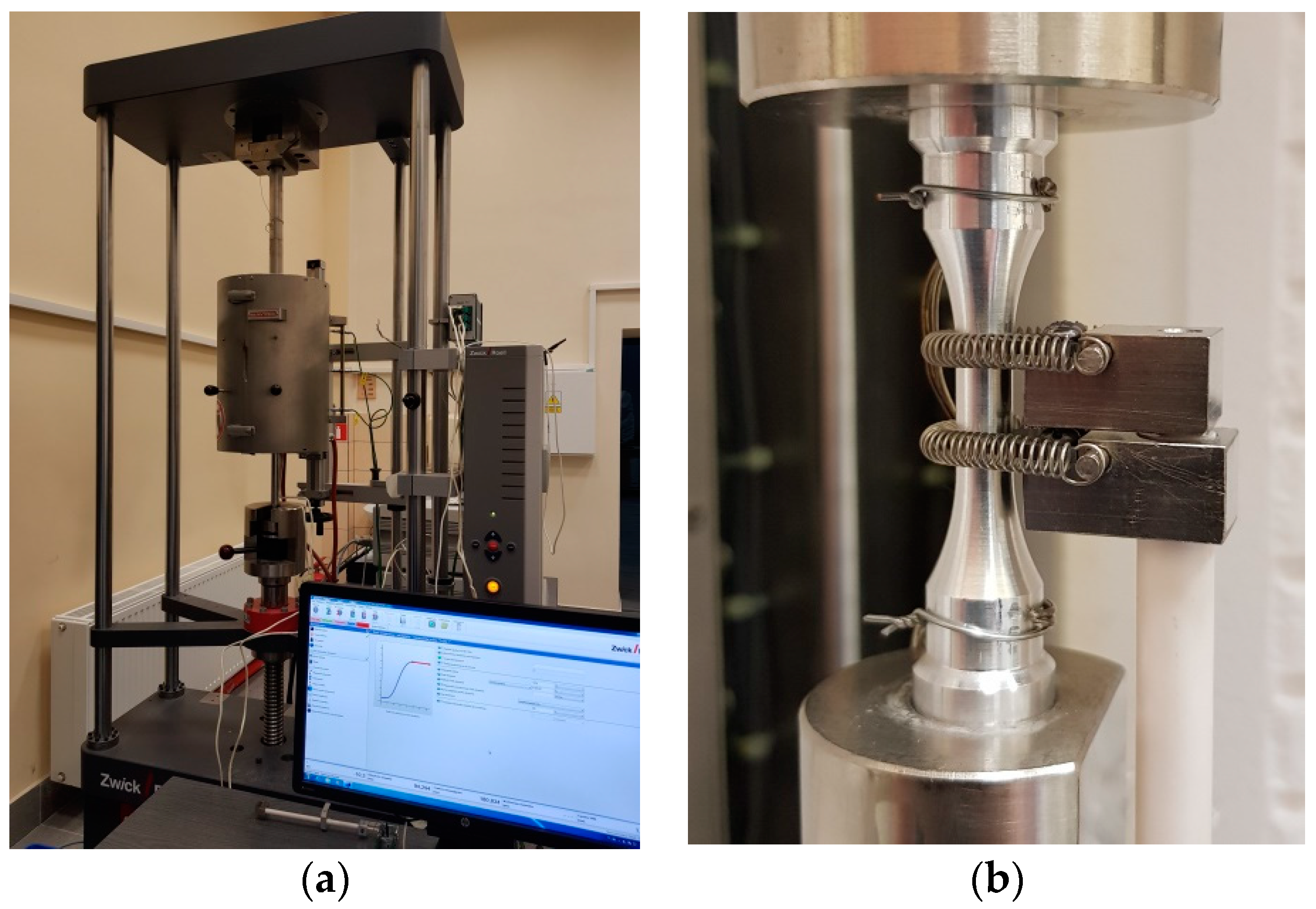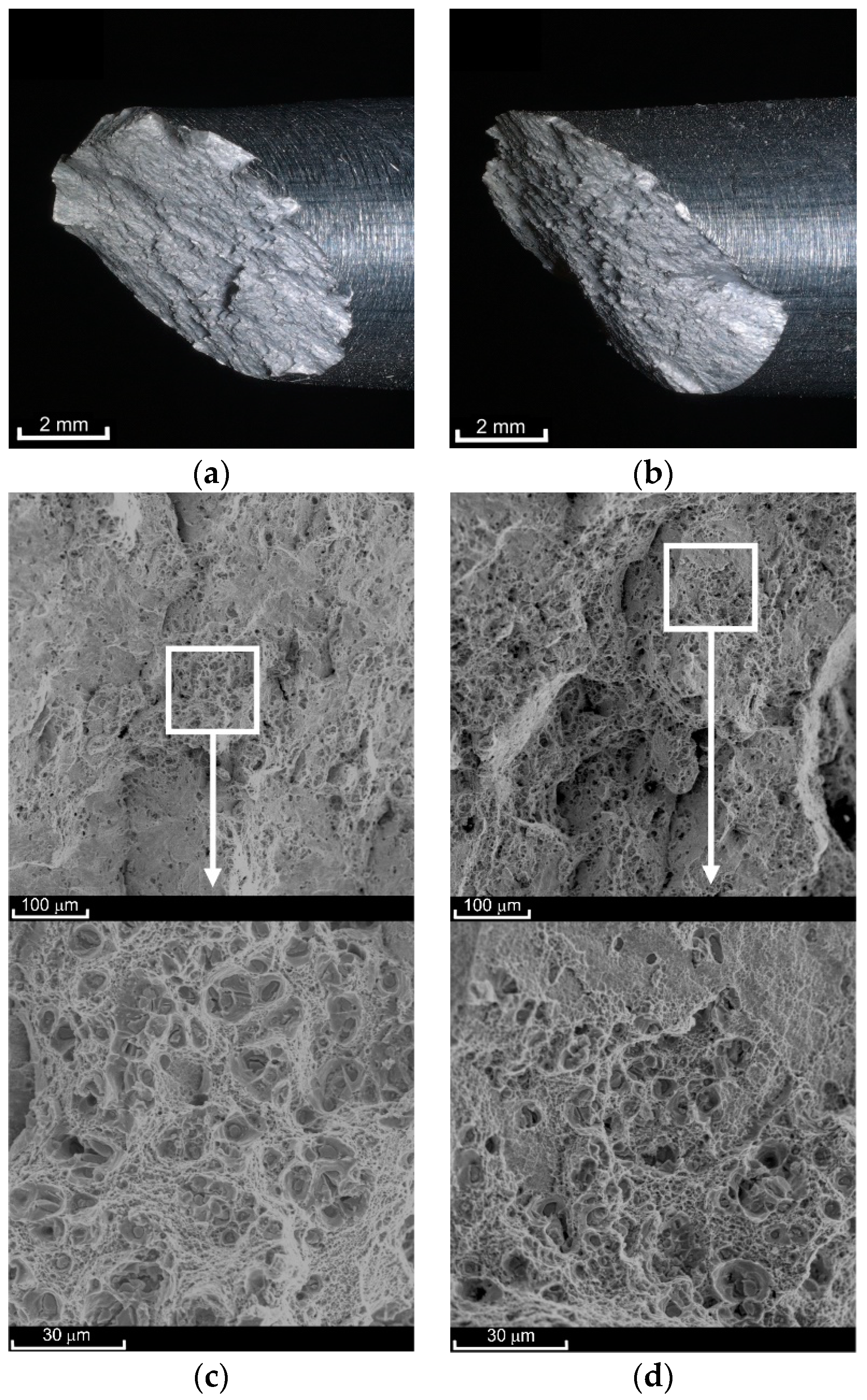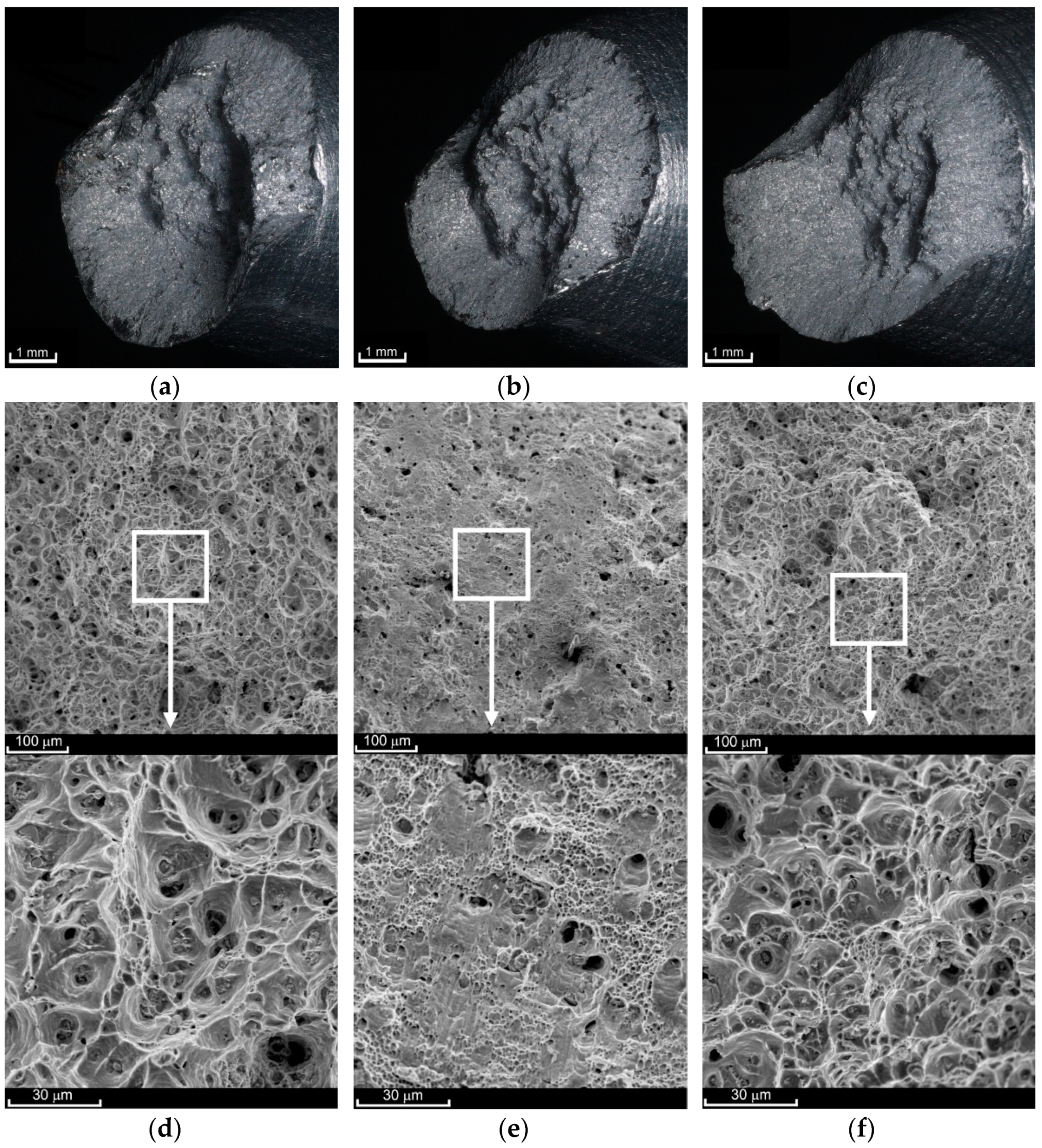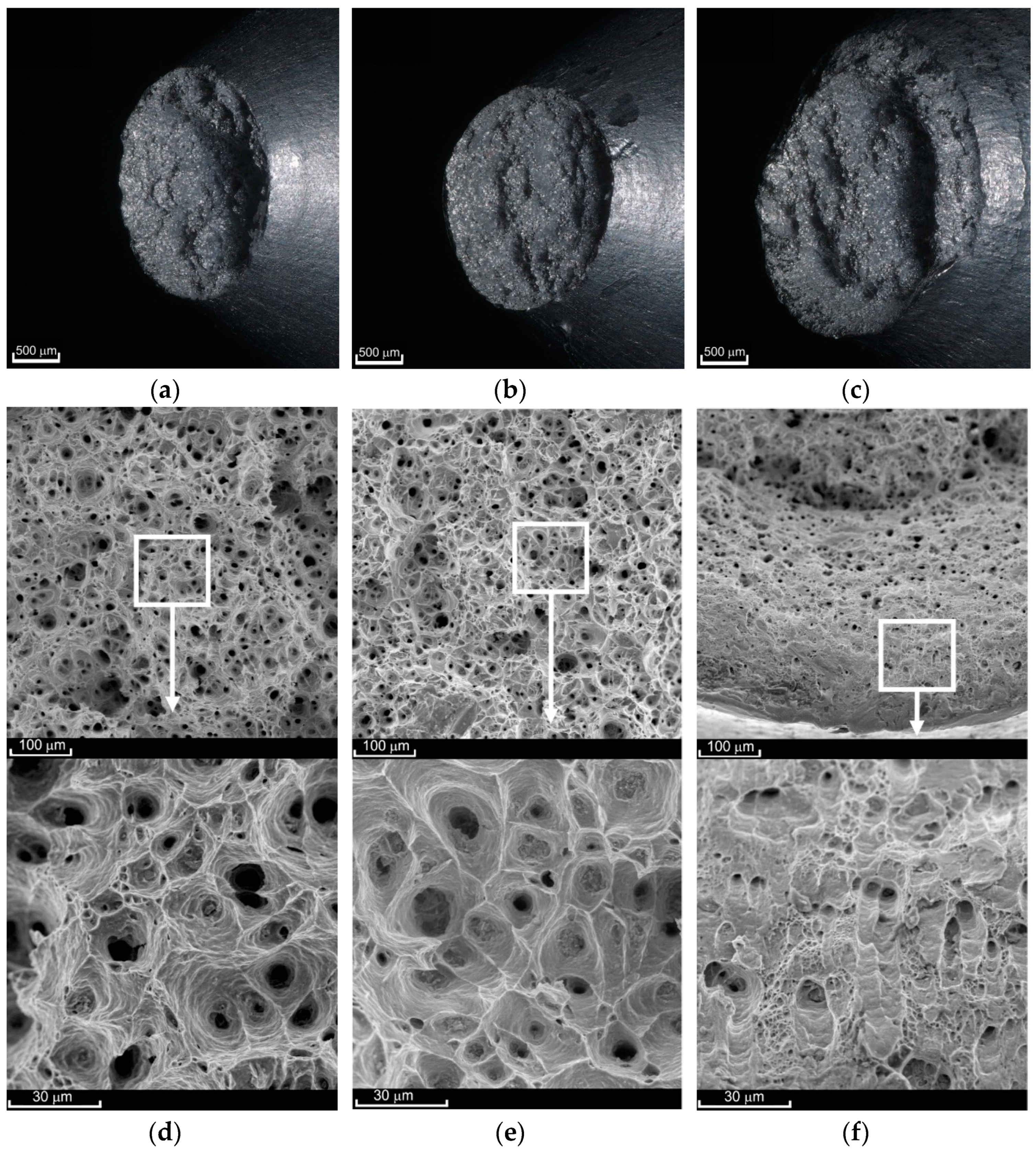Experimental Investigation and Modeling of Damage Accumulation of EN-AW 2024 Aluminum Alloy under Creep Condition at Elevated Temperature
Abstract
:1. Introduction
2. Test Stand, Material Characteristic, Samples
3. Experimental Results and Discussion
3.1. Creep-Rupture Tests
3.2. Microscopic Analysis of Fracture Surfaces
4. A Simple Model for Creep Damage Accumulation
5. Conclusions
Author Contributions
Funding
Institutional Review Board Statement
Informed Consent Statement
Data Availability Statement
Conflicts of Interest
References
- Norton, F.H. The Creep of Steel at High Temperatures, 1st ed.; McGraw and Hill: New York, NY, USA, 1929. [Google Scholar]
- Ranjekar, T.; Mahesh, S. Comparison of continuum damage laws under uniaxial creep for an AISI 316 stainless steel. Trans. Indian Inst. Met. 2018, 71, 935–940. [Google Scholar] [CrossRef]
- Liu, H.Z.; Xie, H.Q.; He, J.D.; Xiao, M.L.; Zhuo, L. Nonlinear creep damage constitutive model for soft rocks. Mech. Time Depend. Mater. 2017, 21, 73–96. [Google Scholar] [CrossRef]
- Zolochevsky, A.; Martynenko, A.; Kühhorn, A. Structural benchmark creep and creep damage testing for finite element analysis with material tension–compression asymmetry and symmetry. Comp. Struct. 2012, 100–101, 27–38. [Google Scholar] [CrossRef]
- Gao, Z.; Liu, W.; Li, Q.H.; Yue, Z.F. Creep life assessment craze damage evolution of polyethylene methacrylate. Adv. Polym. Technol. 2018, 37, 3619–3628. [Google Scholar] [CrossRef] [Green Version]
- Kachanov, L.M. Introduction to Continuum Damage Mechanics; Martinus-Nijhoff: Dordrecht, The Netherlands, 1986. [Google Scholar]
- Rabotnov, Y.N. Creep Problems in Structure Members; North-Holland: Amsterdam, The Netherlands, 1969. [Google Scholar]
- Shlyannikov, V.; Tumanov, A. Creep-fracture resistance parameters determination based on stress and ductility damage models. Fatigue Fract. Eng. Mater. Struct. 2018, 41, 2110–2129. [Google Scholar] [CrossRef]
- Shlyannikov, V.; Tumanov, A. Creep damage and stress intensity factor assessment for plane multi-axial and three-dimensional problems. Int. J. Solids Struct. 2018, 150, 166–183. [Google Scholar] [CrossRef]
- Hayhurst, D.R. Creep-rupture under multiaxial state of stress. J. Mech. Phys. Solids 1972, 20, 381–390. [Google Scholar] [CrossRef]
- Liu, Y.; Murakami, S. Damage localization of conventional creep damage models and proposition of a new model for creep damage analysis. JSME Int. J. Ser. A 1998, 41, 57–65. [Google Scholar] [CrossRef] [Green Version]
- Murakami, S.; Liu, Y.; Mizuno, M. Computational methods for creep fracture analysis by damage mechanics. Comput. Methods Appl. Mech. Eng. 2000, 183, 15–33. [Google Scholar] [CrossRef]
- Othman, A.M.; Hayhurst, D.R.; Dyson, B.F. Skeletal point stresses in circumferentially notched tension bars undergoing tertiary creep modelled with physically based constitutive equations. Proc. R. Soc. Lond. A 1993, 441, 343–358. [Google Scholar]
- Othman, A.M.; Dyson, B.F.; Hayhurst, D.R.; Lin, J. Continuum damage mechanics modelling of circumferentially notched tension bars undergoing tertiary creep with physically-based constitutive equations. Acta Metall. Mater. 1994, 42, 597–611. [Google Scholar] [CrossRef]
- Kowalewski, Z.L.; Hayhurst, D.R.; Dyson, B.F. Mechanisms-based creep constitutive equations for an aluminium alloy. J. Strain Anal. Eng. Des. 1994, 29, 309–316. [Google Scholar] [CrossRef]
- Altenbach, H.; Altenbach, J.; Naumenko, K. On the prediction of creep damage by bending of thin walled structures. Mech. Time Depend. Mater. 1997, 1, 181–193. [Google Scholar] [CrossRef]
- Li, B.; Lin, J.; Yao, X. A novel evolutionary algorithm for determining unified creep damage constitutive equations. Int. J. Mech. Sci. 2002, 44, 987–1002. [Google Scholar] [CrossRef] [Green Version]
- Perrin, I.J.; Hayhurst, D.R. Creep constitutive equations for a 0.5Cr-0.5Mo-0.25V ferritic steel in the temperature range 600 °C to 675 °C. J. Strain Anal. Eng. Des. 1996, 31, 299–314. [Google Scholar] [CrossRef]
- Mustata, R.; Hayhurst, R.J.; Hayhurst, D.R.; Vakili-Tahami, F. CDM predictions of creep damage initiation and growth in ferritic steel weldments in a medium-bore branched pipe under constant pressure at 590 °C using a four-material weld model. Arch. Appl. Mech. 2006, 75, 475–495. [Google Scholar] [CrossRef]
- Pétry, C.; Lindet, G. Modelling creep behaviour and failure of 9Cr-0.5Mo-1.8W-VNb steel. Int. J. Press. Vessels Pip. 2009, 86, 486–494. [Google Scholar] [CrossRef]
- Hayhurst, R.J.; Dean, D.W. CDM prediction of creep failure modes in thin and thick section Cr-Mo-V Butt-welded pipes under combined internal pressure and end loads at temperatures in the range 540–620 °C. Fatigue Fract. Eng. Mater. Struct. 2011, 34, 689–707. [Google Scholar] [CrossRef]
- Hosseini, E.; Holdsworth, S.R.; Mazza, E. Stress regime-dependent creep constitutive model considerations in finite element continuum damage mechanics. Int. J. Damage Mech. 2013, 22, 1186–1205. [Google Scholar] [CrossRef]
- Nikbin, K.M.; Smith, D.J.; Webster, G.A. Prediction of creep crack growth from uniaxial creep data. Proc. R. Soc. Lond. A 1984, 396, 183–197. [Google Scholar]
- Yatomi, M.; Nikbin, K.M.; O’Dowd, N.P. Creep crack growth prediction using a damage based approach. Int. J. Press. Vessels Pip. 2003, 80, 573–583. [Google Scholar]
- Cocks, A.C.F.; Ashby, M.F. Intergranular fracture during power-law creep under multiaxial stresses. Metal. Sci. 1980, 14, 395–402. [Google Scholar]
- Tabuchi, M.; Hongo, H.; Li, Y.K.; Watanabe, T.; Takahashi, Y. Evaluation of microstructures and creep damages in the HAZ of P91 steel weldment. J. Press. Vessel Technol. 2009, 131, 021406. [Google Scholar]
- Chen, L.Y.; Wang, G.Z.; Tan, J.P.; Xuan, F.Z.; Tu, S.T. Effects of residual stress on creep damage and crack initiation in notched CT specimens of a Cr-Mo-V steel. Eng. Fract. Mech. 2013, 97, 80–91. [Google Scholar]
- Pettinà, M.; Biglari, F.; Heaton, A.; Brown, P.; Nikbin, K. Modelling damage and creep crack growth in structural ceramics at ultra-high temperatures. J. Eur. Ceram. Soc. 2014, 34, 2799–2805. [Google Scholar]
- Zhao, L.; Alang, N.; Nikbin, K. Investigating creep rupture and damage behaviour in notched P92 steel specimen using a microscale modelling approach. Fatigue Fract. Eng. Mater. Struct. 2018, 41, 456–472. [Google Scholar]
- Wen, J.F.; Tu, S.T. A multiaxial creep-damage model for creep crack growth considering cavity growth and microcrack interaction. Eng. Fract. Mech. 2014, 123, 197–210. [Google Scholar]
- Shlyannikov, V.N. Elastic-Plastic Mixed-Mode Fracture Criteria and Parameters; Springer: Berlin, Germany, 2003. [Google Scholar]
- Spindler, M.W. The multiaxial creep ductility of austenitic stainless steels. Fatigue Fract. Eng. Mater. Struct. 2004, 27, 273–281. [Google Scholar]
- Zhang, Y.-C.; Jiang, W.; Tu, S.-T.; Zhang, X.-C.; Ye, Y.-J. Creep crack growth behavior analysis of the 9Cr-1Mo steel by a modified creep-damage model. Mater. Sci. Eng. A 2017, 708, 68–76. [Google Scholar]
- Cardoso, B.R.; Matt, C.F.T.; Furtado, H.C.; de Almeida, L.H. Creep Damage Evaluation in High-Pressure Rotor Based on Hardness Measurement. J. Mater. Eng. Perform. 2015, 24, 2784–2791. [Google Scholar]
- Rui, S.-S.; Shang, Y.-B.; Fan, Y.-N.; Han, Q.-N.; Niu, L.-S.; Shi, H.-J.; Hashimoto, K.; Komai, N. EBSD analysis of creep deformation induced grain lattice distortion: A new method for creep damage evaluation of austenitic stainless steels. Mater. Sci. Eng. A 2018, 733, 329–337. [Google Scholar] [CrossRef]
- Robinson, E.L. Effect of temperature variation on the creep strength of steels. Trans. ASME 1938, 60, 253–259. [Google Scholar]
- Borkowski, P.; Głowacki, D.; Nowakowska, A.; Pawlicki, J.; Zwoliński, J. FE analysis of a steam turbine HP rotor blade stage concerning material effort, dynamic properties and creep damage assessment. Arch. Mech. Eng. 2016, 63, 163–185. [Google Scholar] [CrossRef] [Green Version]
- Loghman, A.; Moradi, M. Creep damage and life assessment of thick-walled spherical reactor using Larson-Miller parameter. Int. J. Press. Vessels Pip. 2017, 151, 11–19. [Google Scholar] [CrossRef]
- Hu, X.; Ye, W.; Ma, X.; Song, Y. A new creep damage assessment method for metallic material under variable load conditions at elevated temperature. Fatigue Fract. Eng. Mater. Struct. 2019, 42, 2725–2737. [Google Scholar] [CrossRef]
- Pavlou, D.G. Creep life prediction under stepwise constant uniaxial stress and temperature conditions. Eng. Struct. 2001, 23, 656–662. [Google Scholar] [CrossRef]
- Batsoulas, N.D. Creep damage assessment and lifetime predictions for metallic materials under variable loading conditions in elevated temperature applications. Mater. Technol. 2009, 80, 152–159. [Google Scholar]
- Wen, Z.; Zhang, D.; Li, S.; Yue, Z.; Gao, J. Anisotropic creep damage and fracture mechanism of nickel-base single crystal superalloy under multiaxial stress. J. Alloys Comp. 2017, 692, 301–312. [Google Scholar] [CrossRef]
- Pettinà, M.; Harrison, R.W.; Vandeperre, L.J.; Biglari, F.R.; Brown, P.; Lee, W.L.; Nikbin, K. Diffusion-based and creep continuum damage modelling of crack formation during high temperature oxidation of ZrN ceramics. J. Eur. Ceram. Soc. 2017, 36, 2341–2349. [Google Scholar] [CrossRef]
- Dyson, B. Use of CDM in materials modelling and component creep life prediction. J. Press. Vessel Technol. ASME 2000, 122, 281–296. [Google Scholar] [CrossRef]
- Chaboche, J.L. Anisotropic creep damage in the framework of continuum damage mechanics. Nucl. Eng. Des. 1984, 79, 309–319. [Google Scholar] [CrossRef] [Green Version]
- Murakami, S. Notion of continuum damage mechanics and its application to anisotropic creep damage theory. J. Eng. Mater. Technol. ASME 1983, 105, 99–105. [Google Scholar] [CrossRef]
- Murakami, S.; Kawai, M.; Rong, H. Finite element analysis of creep crack growth by a local approach. Int. J. Mech. Sci. 1988, 30, 491–502. [Google Scholar] [CrossRef]
- Ganczarski, A.; Skrzypek, J. Application of the modified Murakami’s anisotropic creep-damage model to 3D rotationally-symmetric problem. Tech. Mech. 2001, 21, 251–260. [Google Scholar]
- Ganczarski, A. Lecture Notes in Applied and Computational Mechanics. In Anisotropic Behaviour of Damaged Materials; Skrzypek, J.J., Ganczarski, A.W., Eds.; Springer: Berlin/Heidelberg, Germany; New York, NY, USA, 2003; Volume 9, Chapter 10; pp. 317–349. [Google Scholar]
- Meng, Q.; Wang, Z. Creep damage models and their applications for crack growth analysis in pipes: A review. Eng. Fract. Mech. 2019, 205, 547–576. [Google Scholar] [CrossRef]
- Peravali, S.; Hyde, T.H.; Cliffe, K.A.; Leen, S.B. An anisotropic creep damage model for anisotropic weld metal. J. Press. Vessel Technol. ASME 2009, 131, 021401. [Google Scholar] [CrossRef]
- Tomczyk, A.; Seweryn, A.; Doroszko, M. Monotonic behaviour of typical Al-Cu-Mg alloy pre-strained at elevated temperature. J. Theor. Appl. Mech. 2018, 56, 1055–1068. [Google Scholar] [CrossRef]
- Tomczyk, A.; Koniuszewski, R. Construction of a System for Measuring Sample Elongations at Elevated Temperatures Using Devices Intended for Work at Room Temperature. Patent No. PL 68955 Y1, 31 March 2017. (In Polish). [Google Scholar]
- Ramberg, W.; Osgood, W.R. Description of Stress–Strain Curves by Three Parameters; National Advisory Committee for Aeronautics: Washington, DC, USA, 1943. [Google Scholar]
- Tomczyk, A.; Seweryn, A.; Grądzka-Dahlke, M. The effect of dynamic recrystallization on monotonic and cyclic behaviour of Al-Cu-Mg alloy. Materials 2018, 11, 874. [Google Scholar] [CrossRef] [Green Version]
- Tomczyk, A.; Seweryn, A. Fatigue life of EN AW-2024 alloy accounting for creep pre-deformation at elevated temperature. Int. J. Fatigue 2017, 103, 488–507. [Google Scholar] [CrossRef]
- EN ISO 204: 2009, Metallic Materials, Uniaxial Creep Testing in Tension: Method of Test; ISO: Geneva, Switzerland, 2009.
- Lumley, R.N.; Morton, A.J.; Polmear, I.J. Enhanced creep performance in an Al–Cu–Mg–Ag alloy through underageing. Acta Mater. 2002, 50, 3597–3608. [Google Scholar] [CrossRef]
- Hirakata, H.; Fukuhara, N.; Ajioka, S.; Yonezu, A.; Sakihara, M.; Minoshima, K. The effect of thickness on the steady-state creep properties of freestanding aluminum nano-films. Acta Mater. 2012, 60, 4438–4447. [Google Scholar] [CrossRef]
- Wang, J.T.; Xie, L.; Luo, K.Y.; Tan, W.S.; Cheng, L.; Chen, J.F.; Lu, Y.L.; Li, X.P.; Ge, M.Z. Improving creep properties of 7075 aluminum alloy by laser shock peening. Surf. Coat. Technol. 2018, 349, 725–735. [Google Scholar] [CrossRef]
- Li, L.-T.; Lin, Y.C.; Zhou, H.-M.; Jiang, Y.-Q. Modeling the high-temperature creep behaviors of 7075 and 2124 aluminum alloys by continuum damage mechanics. Comp. Mater. Sci. 2013, 73, 72–78. [Google Scholar] [CrossRef]
- Falkowska, A.; Seweryn, A.; Szusta, J. Predicting the fatigue strength and life of 316L steel sinters of varying porosity for implants in a uniaxial loading state. Eng. Fract. Mech. 2018, 200, 146–165. [Google Scholar] [CrossRef]










| T (°C) | E (GPa) | σc (MPa) | n | K (MPa) |
|---|---|---|---|---|
| 100 | 71 | 536 | 0.0759 | 641 |
| 200 | 70 | 460 | 0.0633 | 542 |
| 300 | 56 | 219 | 0.0097 | 227 |
| T (°C) | σcreep (MPa) | Creep-Rupture Time (h) | εp1 (%) | εp2 (%) |
|---|---|---|---|---|
| 100 | 524 | 20.35 | 5.4 | 19.3 |
| 530 | 2.64 | 6.0 | 18.2 | |
| 532 | 0.45 | 6.6 | 16.9 | |
| 200 | 229 | 89.05 | 0 | 16.2 |
| 235 | 64.73 | 0 | 19.4 | |
| 256 | 24.25 | 0 | 28.8 | |
| 279 | 7.49 | 0 | 26.5 | |
| 297 | 2.69 | 0 | 22.9 | |
| 300 | 51 | 135.83 | 0 | 41.7 |
| 66 | 23.50 | 0 | 45.9 | |
| 75 | 17.93 | 0 | 43.7 | |
| 92 | 4.47 | 0 | 37.7 | |
| 123 | 0.82 | 0 | 33.8 |
| T (°C) | σcreep (MPa) | nω | Aω | Δω1 | Δω2 | ω |
|---|---|---|---|---|---|---|
| 100 | 524 | 12.46 | 8.21 | 0.134 | 0.861 | 0.995 |
| 530 | 0.164 | 0.871 | 1.035 | |||
| 532 | 0.198 | 0.756 | 0.954 | |||
| 200 | 229 | 0 | 0.468 | 0.468 | ||
| 235 | 0 | 0.583 | 0.583 | |||
| 256 | 1.51 | 8.29 | 0 | 0.985 | 0.985 | |
| 279 | 0 | 1.033 | 1.033 | |||
| 297 | 0 | 0.981 | 0.981 | |||
| 300 | 51 | 0 | 0.795 | 0.795 | ||
| 66 | 0 | 0.998 | 0.983 | |||
| 75 | 0.51 | 4.01 | 0 | 1.015 | 1.029 | |
| 92 | 0 | 0.971 | 0.985 | |||
| 123 | 0 | 1.010 | 1.005 |
Publisher’s Note: MDPI stays neutral with regard to jurisdictional claims in published maps and institutional affiliations. |
© 2021 by the authors. Licensee MDPI, Basel, Switzerland. This article is an open access article distributed under the terms and conditions of the Creative Commons Attribution (CC BY) license (http://creativecommons.org/licenses/by/4.0/).
Share and Cite
Tomczyk, A.; Seweryn, A. Experimental Investigation and Modeling of Damage Accumulation of EN-AW 2024 Aluminum Alloy under Creep Condition at Elevated Temperature. Materials 2021, 14, 404. https://doi.org/10.3390/ma14020404
Tomczyk A, Seweryn A. Experimental Investigation and Modeling of Damage Accumulation of EN-AW 2024 Aluminum Alloy under Creep Condition at Elevated Temperature. Materials. 2021; 14(2):404. https://doi.org/10.3390/ma14020404
Chicago/Turabian StyleTomczyk, Adam, and Andrzej Seweryn. 2021. "Experimental Investigation and Modeling of Damage Accumulation of EN-AW 2024 Aluminum Alloy under Creep Condition at Elevated Temperature" Materials 14, no. 2: 404. https://doi.org/10.3390/ma14020404




